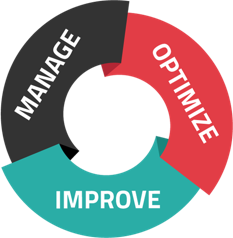
As you've probably noticed, the tech industry seems to "refresh" itself every few months. You don't have to wait very long for a new version of your favorite app, phone, computer, or even network solution. However, that doesn't mean you have to refresh at the same rate as the entire tech industry.
Here's a look at hardware refreshes--what they are, how often they should happen, and why managed IT and IT network services are a great place to start.
Hardware Refresh FAQs
Managed IT experts have seen a little bit of everything. They know the ins and outs of upgrades, refreshes, and new IT setups--which means they can tell you the ins and outs of a hardware refresh.
What is a hardware refresh?
A hardware refresh is your chance to upgrade your entire tech environment. Despite the name, it's not just limited to hardware. Here are a few things you might include in your refresh:
Hardware
- Desktop computers.
- Laptop computers.
- Webcams.
- Printers.
- Storage devices.
Software
- Firewalls.
- Networks.
- Servers.
- Operating systems.
- Applications.
Why is a hardware refresh so important?
Without the occasional refresh, you'd be working with an outdated setup forever--and in the tech world, that's a big risk. Outdated systems cause problems including:
- Reduced performance: You'll notice things like slow response times on your laptop or network connections with lots of lag.
- Increased downtime: Have a last-minute print to make? You're probably out of luck. Outdated IT environments lead to a lot of downtime, which means you can't rely on your hardware or software.
- Impacted security: The older your setup becomes, the less capable it is of protecting you against the latest threats.
- Decreased efficiency: Your outdated machines and software solutions don't have the latest efficiency tools--and they're probably starting to slow down. That's not to mention the cost of constant repairs, troubleshooting, and maintenance.
When should you perform a hardware refresh?
It's best to refresh when warranties start to expire. However, since that time can differ, it's sometimes better to use your efficiency as a guide. Is your tech environment slowing you down? Are you growing more frustrated with your solutions? Are you starting to worry about new security threats? In many ways, you'll know when the time is right for a refresh--your IT setup will tell you!
How Managed IT and IT Network Services Can Help
The good news about a hardware refresh is that you don't have to do it alone. Managed IT and IT network services can help you plan, execute, and track the results of every change you make--which means no more guesswork or unnecessary costs.
Here's how it works:
#1: Analyzing your needs
A managed IT provider can perform what's sometimes called a tech audit. These audits help you and your provider learn more about your environment, including the age and performance of your hardware and software.
#2: Making a plan
Once you know what you're up against, you'll work with your managed IT provider to make a plan for your hardware refresh. This includes elements like choosing new operating systems, addressing security issues, identifying ideal hardware features, and more.
#3: Refreshing in stages
Next, it's time to start the refresh. You'll upgrade in stages instead of all at once--that way, only small sections of your workflow are impacted and downtime is reduced.
#4: Tracking results
Throughout the process, you'll have the chance to repeat audits or track your changes in other ways. This allows you to compare key performance indicators from before and after your refresh, showing you your return on investment.
Managed IT with Digital Watchdog Services
What happens after a hardware refresh? Well, that's where Digital Watchdog comes in.
Just like a real watchdog, this service helps monitor and protect computers, networks, and more. With remote monitoring, antivirus protection, malware removal, and other key solutions, Digital Watchdog relentlessly protects your tech environment and identifies potential issues. It's a great way to ensure that your newly refreshed setup is operating as expected--and that you don't fall into any of the same traps that impacted your performance, uptime, and efficiency to begin with.
Conclusion
A hardware refresh is the perfect chance to make sure your entire tech landscape is on the same page. With help from managed IT and network IT services--plus an extra helping hand from Digital Watchdog services--your refresh can be smooth, effective, and efficient.
Ready to start your own hardware refresh? Contact us today to get started with managed IT and network IT services!



